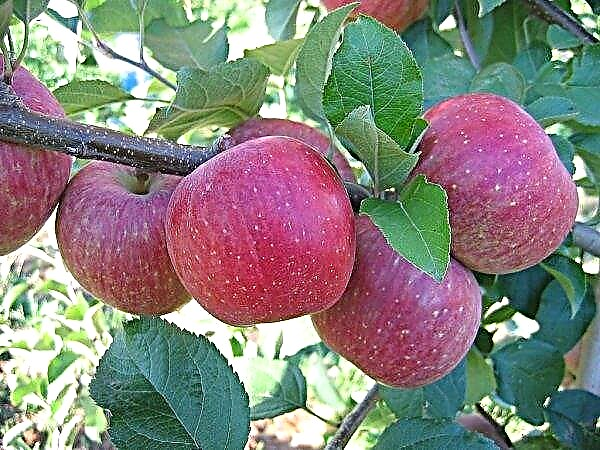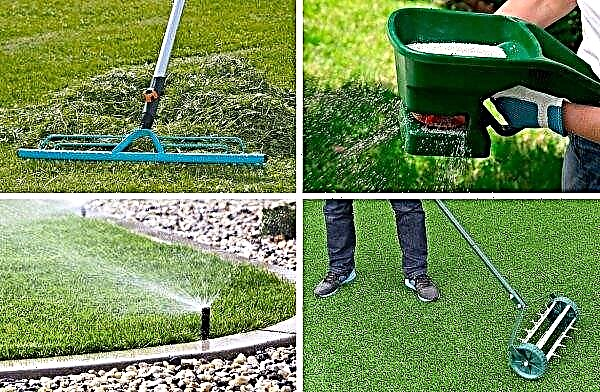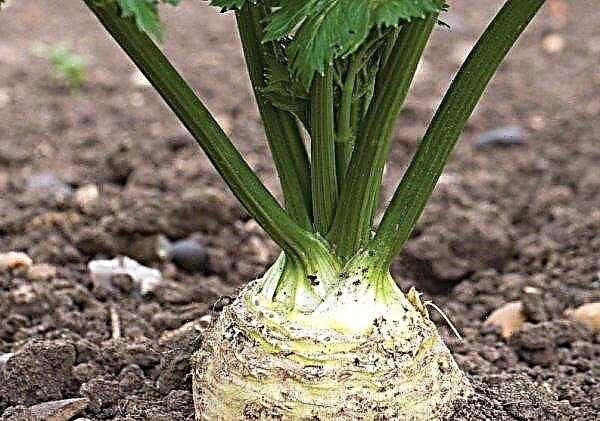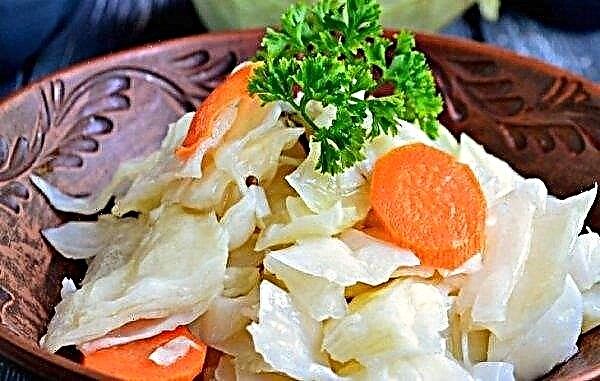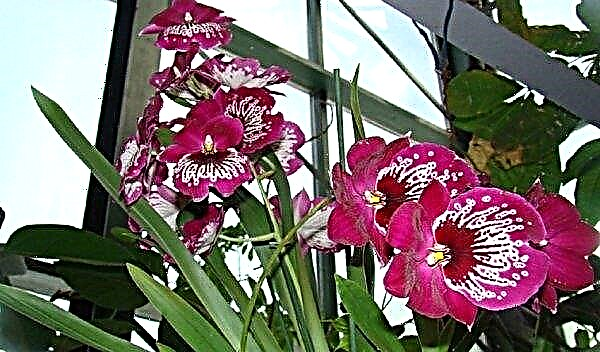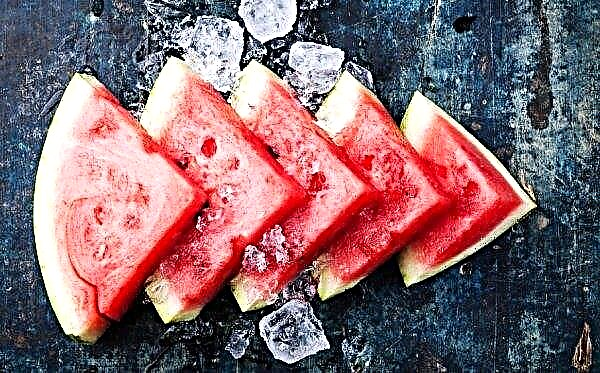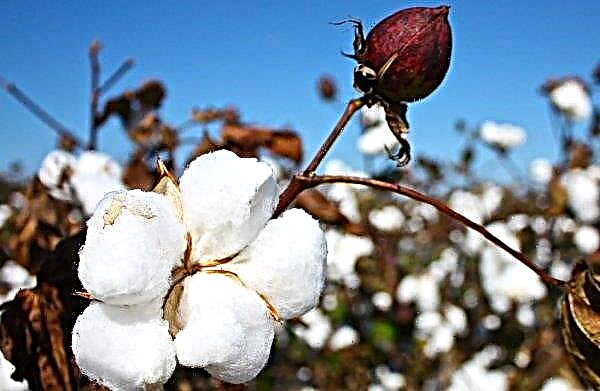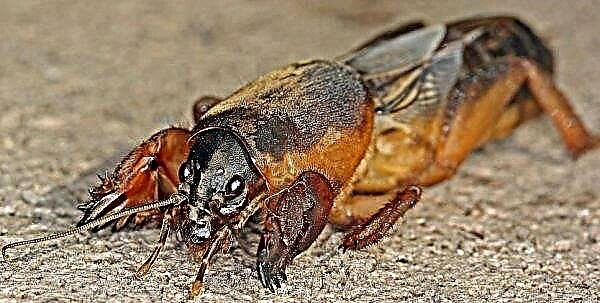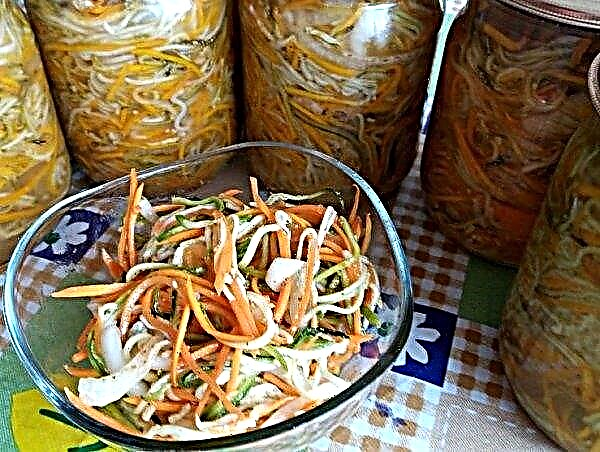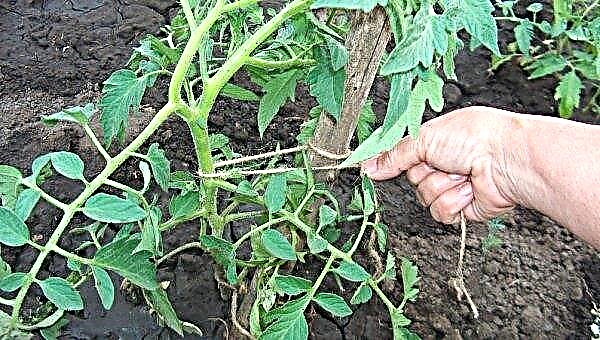Onions are often grown in households for fresh greens. In order to harvest green onions as early as possible, winter varieties were developed that are recommended to be planted in late autumn. This article lists the best varieties of winter onions for greens, the rules for preparing the site and planting material, especially the cultivation of this crop, as well as methods of combating possible pests and diseases.
Rating of the best varieties of winter onions for planting on greens
There are many varieties of onions on greens, which are suitable for planting in the open ground in the winter. They differ in the appearance of inflorescences and the shape of the leaves, have a different taste and ripening time for the first green.
The following article describes the characteristics of the most popular varieties of winter onions per feather, so you can choose which one suits you best.Did you know? The Latin name of the plant is “allium” and translates as “burning”. This name was given to onions by Karl Linnaeus.
Batun
This species has many varieties that can grow in one place for 10 years. But they give the best harvest of greens only in the first 3-4 years.
Variety characteristics are presented below:
- The leaves of the plant have a tubular structure and can reach 40 cm in length and 1.5 cm in width. Their color is dark green, and the surface is covered with a thin layer of wax.
- The root system of the plant is well developed, penetrates the soil to a depth of 60 cm. There is a small false bulb of a cylindrical shape, covered with brown scales.
- The flowering period falls in June, and the height of the peduncle can reach 60-100 cm. The inflorescence has the shape of a spherical umbrella, consisting of small yellow-green flowers.
- Feathers are juicy, have a pleasant taste and a light spicy aroma.
- Harvest green onions can be harvested about 3 times per season. The total amount of greens with 1 m² can reach 3-4 kg.
- The seeds of the plant are small, have a black color and ripen in July.
- When planting under winter, the batun tolerates cold well, and the first shoots appear in early spring.
Slime
The onion variety Slizun is particularly resistant to low air temperatures, so it can be grown in regions with severe winters.
Description of plants of this variety is presented below:
- The leaves are wide and flat, reach a length of 30 cm and are painted in dark green.
- The taste of feathers is slightly spicy, with a slight garlic flavor. In the place of leaf cut, mucous juice is secreted.
- The slime has a well-developed rhizome with a length of about 5 cm and a thickness of up to 3 cm. Filamentous roots extend from it to the sides, penetrating the soil to a depth of 60 cm.
- The plant has a false bulb of cylindrical shape, covered with white scales. Each rhizome is attached to 2-3 bulbs.
- The flowering period lasts from June to mid-July. The flower stalk height is up to 60 cm, and the spherical inflorescence consists of small pink flowers.
- Plant seeds ripen in late summer. They have an irregular shape and black color.
- The yield of this variety from 1 m² can reach 3-4 kg. Cut greens 3-4 times per season.
Important! At the beginning of the flowering period, the heads of the inflorescences of the slug are drooping and then straightened.
Schnitt
This variety has the form of a spreading bush. It is grown not only to obtain a harvest of juicy greens, but also as a decorative decoration of the site.
Characteristics of chives are presented below:
- The height of the green part of the plant can reach 40 cm. The leaves are tubular, have a bright green color.
- The taste of onion feathers is intense, spicy. The leaves are juicy and very tender.
- The root system is branched, penetrates the soil to a depth of 30 cm. The roots are fibrous and form a dense sod under the upper layer of soil.
- A false bulb is formed in late summer. It is small in size and covered with yellow scales.
- The flowering period of plants lasts all summer. The flower stalk height can reach 40 cm, and small spherical inflorescences consist of lilac, white or purple bell-shaped flowers.
- The seeds are small, painted black and ripen in the second half of summer.
- With good care from 1 m² per season, you can collect 4-6 kg of fresh herbs. Cutting can be carried out throughout the summer as new leaves grow.
Tiered Bow
This variety got its name due to the fact that numerous air bulbs are formed on its peduncle, forming several tiers.

The variety description is presented below:
- The leaves of the multi-tier onion are hollow inside, and their length can reach 80 cm. They are painted in dark green color and covered with a layer of wax coating.
- The greens of this variety are very tender and juicy, have a sharp taste and do not roughen over time.
- The root system of the plant is fibrous and branched, penetrates the soil to a depth of 50–70 cm.
- The size of the false bulb is 3-5 cm. Outside, it is covered with brown-purple scales. In the second year of life, it is divided into 3-5 daughter bulbs.
- The flower stalk consists of several tiers of air bulbs that form throughout the summer. The height of the first tier is about 50 cm, and all subsequent ones - up to 20 cm. In one season, 4-5 tiers are formed on the plant.
- Green leaves grow up from the air bulbs, reaching 15 cm in length.
- The yield of the variety is about 4 kg of greens with 1 m² per season. In the first year of cultivation, cutting is carried out 1-2 times, and in subsequent years, up to 3 times per season.
Important! Many-tiered onions are also called Egyptian, they have good resistance to low temperatures and do not have a dormant period; therefore, they are often grown in greenhouses to receive fresh herbs in the autumn and winter months.
Optimal landing times
Planting onions in the winter should be done at the right time so that the planting material can take root, but the seedlings do not have time to appear before the first frost.
The main recommendations for choosing the timing of planting winter onions on greens are listed below:
- it is recommended to place planting material in the ground in the second half of October;
- landing is carried out about a month before the predicted first frosts;
- the air temperature at the time of landing and for several days after it should be about + 5 ° C;
- the temperature on the surface of the soil at the time of planting should be +3 ... + 4 ° C.
Site and bulb preparation
First of all, you need to choose and prepare the site correctly so that the winter onions give good shoots.
Did you know? The homeland of onions is considered to be Southwest Asia, but the exact place of origin of this culture has not yet been established.
When choosing a place for growing winter onions, you need to consider such indicators:
- the selected area should not be in a draft, but should be ventilated;
- this culture grows well only in sunny areas;
- plants need fertile soil with a loose structure and a neutral reaction;
- you can not plant winter onions in the place where water accumulates in the spring - planting material will rot;
- it is recommended to use for growing this crop a plot on which beets, legumes, tomatoes, cabbage or mustard were grown before;
- bad predecessors for winter onions are potatoes, celery or parsley.
The basic rules for preparing the selected site for sowing winter onions are listed below:
- after the autumn harvest, remove all plant debris from the site - they can be a source of fungal infections or pests;
- introduce urea, humus or compost into the soil, and then dig a plot to a depth of about 20 cm - this procedure will enrich the soil with the necessary nutrients;
- before planting, apply potash and phosphorus fertilizers - they will help planting material to take root and survive the winter;
- immediately before planting, the soil on the site must be well loosened.

Before planting winter onions, you need to prepare the sowing itself.
This process consists of the following steps:
- take hard bulbs with a flat surface, without signs of damage;
- the size of the bulbs should be 2.5-4 cm - such planting material will give a sufficient number of feathers;
- soak the selected sevka in a potassium permanganate solution for 20-30 minutes to disinfect, and then dry at room temperature;
- to accelerate the germination of the bulbs, you can cut off the top of them before planting.
Important! The selected planting material should be approximately the same size - this will allow for more uniform seedlings.
Landing methods
Typically, planting onions on greens in the winter is carried out in one of two ways - bridge or tape. The first landing method allows the most economical use of space on the site, and the second is more traditional. The size of the planting material directly depends on how deep the planting will be carried out.
A step-by-step instruction for planting winter onions on greens by the bridge method is presented below:
- To form ridges 10-15 cm high on the surface of the prepared site. Their width should not exceed 1 m, and it is recommended to leave a distance of about 50 cm between adjacent ridges.
- Level the surface of the ridges and loosen it well to a depth of about 7 cm.
- We plant planting material on the prepared ridges, placing the bulbs close to each other. At the same time, they need to be turned down and slightly pressed into the ground to a depth of about 3-5 cm.
- If the soil on the site is dry - planted material is watered with a small amount of water.
- Mulch the plot with beds with a layer of fallen leaves, needles or spruce branches.

The algorithm for planting winter onions on greens with a tape method is presented below:
- On the surface of the soil, make furrows with a depth of about 3-5 cm. The distance between adjacent furrows should be at least 20 cm.
- Turn the bulbs upside down and place them on the bottom of the furrow at a distance of 10 cm from each other.
- Sprinkle planting material with loose earth. If necessary, slightly water the beds with water.
- Mulch the soil with a layer of mowed grass, coniferous branches or fallen leaves.
Care Features
Autumn planting of bulbs in open ground is carried out with the aim of their early rooting, and after this procedure the beds do not require any care. If the winter is not snowy and severe frosts are observed, then planted bulbs covered with mulch can be additionally covered with a film. But with the onset of spring, it must be removed so that the planting material does not begin to rot and can sprout.
Did you know? In ancient Egypt, onions were used 3000 years BC. e. as food for slaves during the construction of the Cheops pyramid.
Caring for winter onions with greens begins with the onset of early spring.
Its main rules are listed below:
- when warm and sunny weather is established in spring, you can free the bed with winter onions from snow - this will accelerate the heating of the soil and the appearance of the first shoots;
- the first fertilizing onions with fertilizers is carried out after thinning the beds. To do this, use a mullein infusion diluted with water in a ratio of 1: 5;
- the second feeding of onions is carried out 2-3 weeks after the first fertilizer application, but only if the plants grow very slowly. To do this, you can use a solution prepared from 10 liters of water and 4 tbsp. l mixtures of potassium salt, nitrate and superphosphate, taken in a ratio of 1: 1: 2;
- watering the beds in the first 14 days after emergence should be plentiful. It is carried out as the top layer of the earth dries up, and then about once every 8-12 days;
- weeding of weeds is carried out regularly as they appear. It is especially important to remove weed during active onion growth;
- soil loosening is carried out after irrigation and provides better soil permeability;
- you can cover the rows of onions with a layer of mulch from dry straw - this will help reduce the need for frequent loosening of the soil.

Pest and Disease Control
Sometimes when growing winter onions on a feather, plants can be attacked by pests or hurt. To save the crop, you need to be able to identify the problem in time and take the necessary steps to solve it.
Important! To obtain a generous crop of quality greens, onions are not recommended to be treated with chemicals.
A list of the most common pests and diseases of green onions is presented below:
- Onion fly. The insect lays eggs on the soil surface, and after 5 days, larvae hatch from them. The pest eats the underground part of the plants, which leads to yellowing and wilting of the shoots. To combat the pest, row-spacings are watered with concentrated saline (300 g of salt per 10 l of water) with an interval of 10-14 days. For prevention, autumn digging of the site is carried out, and planting material is disinfected before planting.

- Secretive Proboscis (onion weevil). The size of the beetle does not exceed 2.7 mm, and its larvae have a length of about 6 mm. Pests feed on the flesh of the leaves, laying eggs inside them. The larvae hatching after 5–7 days cause yellowing of the leaves, and light spots appear on them. To combat use a mixture of tobacco dust and ash (1: 2 ratio), which is sprayed with the affected plants after watering. For prevention, you need to regularly loosen the soil around the plants, remove last year's plant debris and observe crop rotation.

- Thrips. Insects and their larvae are small (not more than 1 mm) and suck out the juice from the green leaves of the onion. Signs of damage include leaf deformation, slowing plant growth, and softening of the stem. To combat thrips, a solution of 10 l of water and 1 kg of red hot pepper is prepared. The mixture is boiled, cooled, and then diluted with clean water (for 125 ml of solution - 10 l of water). Affected plants are sprayed with an interval of 10-14 days. To prevent the appearance of thrips, autumn digging of the site and regular loosening of the soil are carried out, and celandine or mustard is planted around the perimeter of the beds.

- Peronosporosis (downy mildew). The causative agent of the disease is a fungus that can winter in the upper layers of the soil. On affected plants, the leaves become covered with pale green spots, which eventually become gray-purple. For treatment, you need to remove diseased plants from the site, reduce watering and completely remove fertilizing. For prevention, you need to plant onions in a well-ventilated place and observe the correct watering regimen.

- Onion rust. The disease is characterized by the appearance on the green leaves of the plant of yellow convex formations in which the spores of the fungus mature. The leaves begin to turn yellow and dry, and the fungus spreads to other plants. Sick plants are removed, and then make adjustments to the irrigation mode. For prevention, you need to carry out autumn digging of the site and remove the remnants of last year's plants.

Dates of collection and storage features of onions
Fresh greens are formed constantly in the process of plant growth, so there is no clear time frame for its cutting. You can harvest green feathers immediately after their length has reached 30 cm. At the same time, the leaves retain a dense structure, hold their shape well, do not break and are convenient to transport. After cutting the greens, the crop is re-harvested after the leaves grow back.
Did you know? In the Middle Ages, the French during the Crusades traded their prisoners from the Saracens for several heads of onions.
The cut green onion leaves are stacked horizontally in bunches and used fresh. They can be stored in the refrigerator for 2–5 days.
After a long winter, chives are in high demand, as they are a good source of vitamins and nutrients.Using the recommendations listed in this article, you can independently grow winter onions in your area and get an early harvest of tasty and healthy greens.









